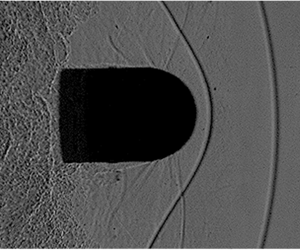Article contents
Flow interactions on supersonic projectiles in transitional ballistic regimes
Published online by Cambridge University Press: 11 May 2020
Abstract

A projectile moving in the transitional/intermediate ballistic regime encounters many complex flow phenomena as the flow field contains two blast waves and several flow interfaces. The aerodynamic characteristics of the projectile are highly influenced by the interaction of the projectile with the surrounding flow field. The present study aims to experimentally visualize the flow structures associated with a moving projectile in the immediate vicinity of the launch tube (transitional/intermediate ballistic regime). In this work, the main focus is to investigate three significant phenomena which normally occur in the transitional ballistic regime and have significant effects on the aerodynamic characteristics of the projectile. These are the moving projectile-standing shock interaction termed as unsteady shock diffraction, shock generation due to the transition in the relative projectile Mach number and the moving projectile-moving shock interaction known as the projectile overtaking phenomenon. Experiments are carried out with projectiles of various configurations for various projectile Mach numbers. The flow field is visualized using time-resolved schlieren and shadowgraph flow visualization techniques. The experiments could capture several interesting features of projectile-flow interactions such as the unsteady shock diffraction, shock generation and overtaking phenomenon in various flow regimes through visualization and quantification of the images using image processing techniques.
JFM classification
Information
- Type
- JFM Papers
- Information
- Copyright
- © The Author(s), 2020. Published by Cambridge University Press
References
Athira et al. supplementary movie 1
Unsteady shock diffraction and interaction of secondary blast wave (corresponding to test-7 in table 1 and figure 8 in the manuscript).
- 8
- Cited by

